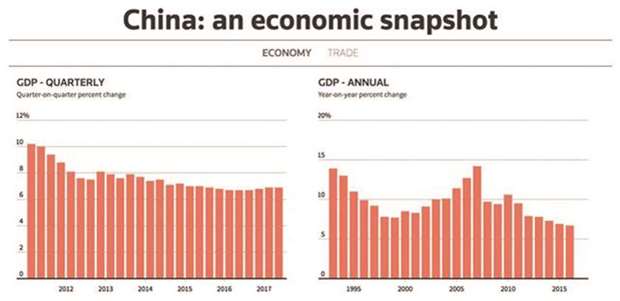China’s central bank yesterday nudged up money market rates as authorities sought to defuse financial risks without imperilling the economy, a balancing act that they have managed successfully so far this year as activity remained broadly steady.
The world’s second-biggest economy has started to cool in recent months amid a government crackdown on high-risk lending and polluting factories, and the move by the People’s Bank of China (PBoC) – coming hours after an anticipated US Federal Reserve rate hike – signalled that Beijing will keep policy tighter next year.
A flurry of data on the day highlighted the economic impact of government efforts to wean China off its years-long addiction to debt, with industrial output, investment and property market all backing evidence of a moderation in momentum.
Analysts said the PBoC rate hikes, widely seen as a backdoor approach that avoids the need to raise benchmark policy rates, will not impede activity though they signalled a commitment by authorities to continue curbing leverage.
“It’s more a symbolic move which helps stabilise market expectations after the Fed rate hike,” said Wen Bin, an economist at Minsheng Bank in Beijing.
He noted that the gap between 10-year US and Chinese bond yields has widened to 160 basis points so the 5 bps rise will not put any pressure on the yuan, which slumped in 2016 before recovering this year after authorities slapped a range of capital control measures.
“They want to narrow the gap between operating interest rates and market interest rates for financial institutions, otherwise it could give financial institutions the wrong impression and lead to arbitrage and an increase in leverage.”
The PBoC increased rates on reverse repurchase agreements, or reverse repos, used for open market operations by 5 basis points for the 7-day and 28-day tenors.
It increased rates on its one-year medium-term lending facility (MLF) also by 5 basis points.
Also yesterday, the PBoC raised interest rates on its standing lending facility (SLF) short-term loans by 5 basis points, sources with direct knowledge of the matter said.
A trader at an asset management firm in Shanghai said that the yield on 10-year Chinese government bonds fell 2-3 basis points after the PBoC’s announcement, as some had expected a bigger move.
However, he expects the broader trend of higher yields will continue amid the ongoing campaign to reduce financial risk.
It was the first rate increase by the Chinese central bank since March, but market interest rates have risen on their own in the interim as the government pursued a range of policies to lower debt in the economy.
That has dragged on activity, a fact underscored by yesterday’s National Bureau of Statistics data releases which showed industrial output was up 6.1% in November year-on-year, versus forecasts for an increase of 6%, but below the 6.2% gain in October.
China’s fixed-asset investment growth also slowed to 7.2% in the January-November period, from the 7.3% expansion in the January-October months.
Along with the rest of trade-dependent Asia, China’s economy gained a lift this year from an exports boom, while a government-led infrastructure spending spree and a resilient property market drove growth in the Asian giant to a surprisingly strong 6.9% in the nine months of the year.
Growth has been cooling in recently, however, hurt by higher borrowing costs while tighter rules on polluting factories have crimped production.
As northern China officially entered the heating season in mid-November, the government has also stepped up efforts to address winter smog, ordering many steel mills, smelters and factories to curtail or halt production.
The curbs saw China’s daily crude steel output slide in November to the lowest in nine months “Economic operations are generally steady and economic growth is more resilient... so this provides a good time window for stepping up structural reforms, including pollution controls,” statistics bureau spokesman Mao Shengyong told reporters following a regular press conference yesterday.
The construction boom has driven up demand for everything from cement to steel and lifted prices of commodities.
A red-hot property market has also been a major growth driver of China’s economy this year, but a slowdown is expected as more cities unveil measures to curb soaring home prices and banks raise mortgage rates in response to tighter policy.
New construction starts measured by floor area accelerated 6.9% in January-November, though property investment slowed to 7.5% on-year in that period, from a 7.8% gain in the first 10 months of 2017.
Yesterday’s data also showed growth of private investment slowed a touch to 5.7% in January-November.
Retail sales gained 10.2% in November on-year, just above the prior month, likely boosted by China’s annual 24-hour shopping binge on November 11, known as Singles’ Day, when sales hit $38.25bn – exceeding combined revenue for Black Friday and Cyber Monday in the United States.
Taken together, the data suggest economic growth is still expected to easily meet or beat the government’s full-year target of around 6.5% and signalled that China has sufficient headroom to keep policy tight over the next year.
“The adjustment of China’s money market rate hike will continue to remind investors that financial de-leverage is a long haul project for China,” OCBC economist Tommy Xie wrote in a note.
Meanwhile, China’s central bank raised interest rates on its standing lending facility (SLF) short-term loans by 5 basis points yesterday, sources with direct knowledge of the matter said.
The increase came after the People’s Bank of China raised rates on reverse repos and medium-term lending facility (MLF) loans earlier in the day, just hours after the Federal Reserve raised the US benchmark, as Beijing seeks to prevent destabilising capital outflows without hurting economic growth.
The interest rate for overnight SLF loans will be raised to 3.35% from 3.30%. Rates for 7-day and one-month loans will be increased by 5 bps each to 3.50% and 3.85%, respectively, sources said.

.


